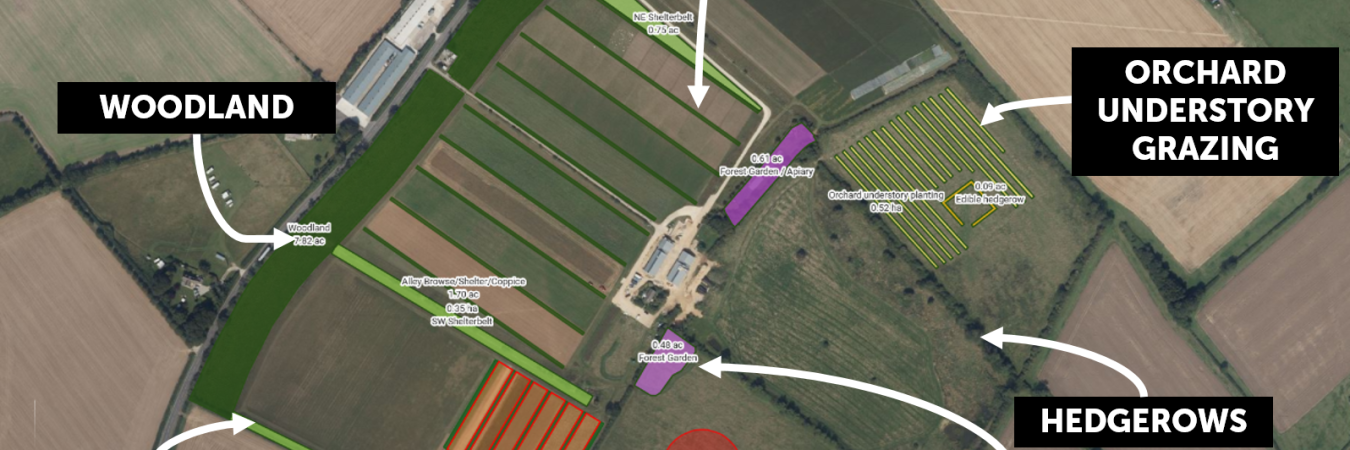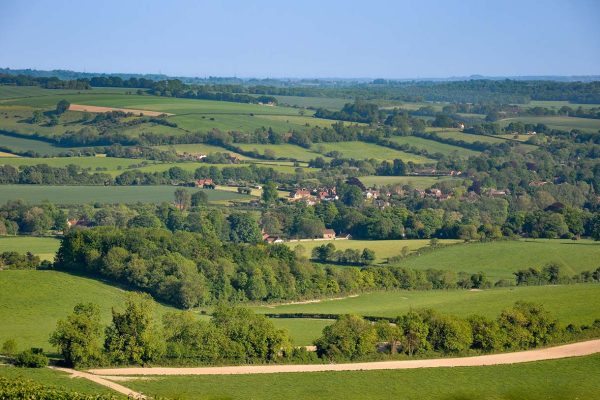Planting a living textbook for agroforesty at FarmED
Whether conventional, organic, regenerative, agroecological, or any other flavour of farming, it seems more and more farmers are getting interested in agroforestry. I’m not sure what it is, but the idea of integrating trees within crop or livestock operations seems to transcend many of the usual polarities found in conversations around food system change.
There are some great examples of agroforestry in the UK, both new and old, with more farmers leading the way. Yet for many, the idea of planting trees in fields is met with a more cautious form of excitement and curiosity. And understandably so – agroforestry requires long term thinking – something that feels more and more challenging as we navigate the uncertainties presented by climate change, the pandemic, Brexit, and of course ELMS.
Despite these uncertainties many people want to make a start with agroforestry, recognising the wisdom in the old saying, ‘the best time to plant a tree was 20 years ago, the second-best time is now’. We need pioneers like this now more than ever, especially if agroforestry initiatives are going to offer a meaningful contribution to the Government’s ambition to plant 30,000 hectares of trees per year until 2050. However, for pioneer efforts to be worthwhile, support is needed to ensure agroforestry systems are designed in a way that is aligned with farm objectives and are manageable in the long run.
At FarmED in the Cotswolds we are developing an ‘Agroforestry Living Textbook’ to showcase inspiring agroforestry systems for arable, livestock and horticultural operations. As a demonstration farm and education centre our plan is to utilise parts of our land to test different types of agroforestry to help farmers and other land stewards think about how they could integrate trees on their land. Each of these systems will represent a different ‘chapter’ to the textbook. We hope the centre will provide inspiration and contribute to the wider agroforestry movement, currently being spear-headed by the National Network of Agroforestry Farms Project.

Design layout of the intended ‘Agroforestry Living Textbook’ at FarmED. Different agroforestry systems will offer demonstrations of silvopastoral, silvoarable, and silvohorticulture systems, as well as food forests and hedgerows. Map produced by FarmED using the Landapp
Different agroforestry systems will offer demonstrations of silvopastoral, silvoarable and silvohorticulture systems, as well as food forests and hedgerows. Starting with our 8-year arable rotation demonstration (split across eight adjacent plots) we will be planting rows of different tree species mixes to provide wind shelter and nutritional browse for the sheep and cattle that mob-graze our herbal leys and cover crops. From hybrid willows and poplar to fast and slow growing native broadleaf mixes, each of these alleys will be managed through varying short and long coppice rotations to demonstrate different growth rates, management techniques and end uses for the harvested wood. An important design consideration for this silvopastoral/silvoarable system has been to plan coppice schedules to minimise shade for the arable crops while maximising browse and shelter for the livestock during grazing periods of the rotation.
In the market garden, we’re working with our resident Community Support Agriculture (CSA) growers, the Kitchen Garden People, to create diverse food producing tree alleys. By integrating fruit trees and shrubs as well as perennial vegetables, the CSA hopes to extend their growing season to provide more food for their members while also attracting pollinators and other beneficial insects to support their vegetable production.
Over in the orchard we’ve begun grazing sheep under the fruit and nuts trees, demonstrating how livestock can be integrated into existing tree crop systems, not just the other way round. Future plans for the ‘Living Textbook’ include understory planting of soft fruits in the orchard tree lines, creating shelterbelts, and a forest garden which will serve to produce food and an inspiring outdoor learning environment embodying a number of ecological principles. And let’s not forget the importance of maintaining the existing hedgerows!
Designing these systems has been an exciting process, but more often than not it’s been difficult seeing the trees from the wood! Many questions often lead to more questions rather than straight forward answers. Which tree species should we plant, how many and in what pattern? Do we need tree guards, fencing or both? What are we going to do with all the food and biomass we produce? While the answers to these questions will be different for every farm, the agroforestry systems we demonstrate will highlight transferable principles to show visitors what they could do, while also pointing out mistakes to avoid! We are fortunate to have received advice from a number of brilliant agroforestry practitioners and researchers in the UK and in doing so have realised that we’re not alone in trying to find answers to all these questions.
We’ve also realised that there is a huge need for advice and training in agroforestry and so have teamed up with some of the UK’s leading agroforesters to offer an Agroforestry Design Masterclass this September at FarmED to help farmers and other land stewards get ready for this year’s tree-planting season. In this two-day group workshop participants will be guided through design exercises and 1:1 clinic sessions with Ben Raskin, Niels Corfield and Tirion Keatinge. Participants learn important design considerations for establishing and managing agroforestry and will walk away having developed a plan for their priority farm area. Places are limited and tickets are selling fast.
We plan to start planting this winter so keep an eye on the FarmED website for news about planting days and other exciting plans! Or if you are eager to get planting this season join us for the Agroforestry Design Masterclass on the 8th & 9th September 2021 at FarmED, and let us know what questions you have about agroforestry on twitter @RealFarmED.
Edd Colbert writes of himself “I’ve travelled the world conducting investigations on food waste and unfair trading practices, using the stories I’ve heard from farmers to campaign for change in the UK and Europe. During this time, I yearned to be more actively involved in farming which led me to undertake a horticultural apprenticeship before completing an MSc in Agroecology. Having spent time in Kenya working with small-holder farmers, I returned to the UK in 2020 to join the FarmED team as Program Co-ordinator, where my role is to develop a series of agroecological training events to empower people to find their role within the global food movement. I believe food offers a vital opportunity for connecting people with the natural world and am fascinated by the potential for working with nature to regenerate our planet while nourishing people.”




